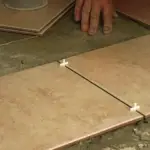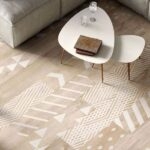
decorative tiles
Join the tile decorating trend and create themed walls in all rooms. The use of patterned tiles in bathrooms and kitchens is a great classic, now being reinvented and also invading living rooms, bedrooms and all kinds of commercial establishments. A trend that was hitting hard and couldn’t be more versatile and practical.
What are tiles and the advantages of decorating with them
Tiles are waterproof ceramic pieces that generally consist of a clay base covered with a layer of glaze, although some ceramic tiles do not. The materials with which they are made give them a series of advantages that make them ideal for covering all types of walls. between them:
cleverness
One of the main advantages of tiles is their versatility. You can find and buy tiles in endless shapes, thicknesses, finishes, and designs. A feature that allows for a level of customization when decorating a room that no other type of cladding can offer.
resistance
Tiles are really resistant coatings. They do not suffer from humidity or high temperatures and withstand scratches and bumps well. In addition, they do not require much maintenance.
Easy to install
A little putty and the right number of tiles are the only materials needed to decorate a wall with ceramic tile cladding in no time.
Ease of cleaning
A damp rag and, if desired, a cleaning product is enough to leave the stained tiles looking like new. Its permeability prevents stains from filtering and damaging the material and makes it much easier to clean. That is why it is the ideal coating for kitchens, but also for catering establishments, stores and even children’s rooms.
good price
Ceramic tile is a fairly inexpensive coating. Its cost will depend on the quality of the materials used in its manufacture and design.
Tile types
Tile is a versatile type of cladding. There are endless types of tiles that we can categorize by their shape, materials or finishes, among other characteristics.
Types of tiles in terms of shape and terrain
Most tiles are rectangular or square in shape, but it’s a material that can be made into just about any shape imaginable. You can find hexagonal, octagonal, or even round tiles.
In addition to the figure, you have to take into account the comfort. Many tiles are smooth, no matter what pattern they have, but there are also tiles with different types of patterns, which provide a lot of decorative play.
Types of tiles and their materials
There are many materials, both primed and coated, that are used to make ceramic tiles or tiles. The most common are:
clay tiles
This type of tile is the most handcrafted. It is made of clay baked in kilns at high temperatures, without a ceramic coating.
red or white body tiles
Red or white putty tiles are the most widely used par excellence in both bathrooms and kitchens. They are made of ceramic-coated clay and are the lightest and cheapest, but they are not recommended for exterior facades.
stoneware
Porcelain stoneware is a more resistant type of tile, so it can be used for floors and wall coverings. It is made of red clay cooked at very high temperatures.
porcelain tiles
Porcelain tiles are ceramic products made of high quality enamel. The possibilities are endless in terms of colors, designs and finishes. They are the most commonly used tiles as decorative elements in all types of rooms.
glass tiles
Glass tiles allow you to play with shapes, colors, and transparencies. Its placement is a trend in both bathrooms and other rooms.
Stone tile, marble or slate
These durable materials are incorporated into the linings and are very fashionable. The latest technologies allow the manufacture of light and highly resistant tiles or marble.

Types of tiles at the end
The different materials and coatings used to make the tiles give them different finishes. You can find:
Satin tile: does not shine.
Glossy or high-gloss tiles: with glossy enamel coating.
Coarse tile: It is the most natural finish of burnt clay tile available with or without gloss.
How to choose decorative tiles
Its resistance and ease of cleaning make tiles the paint par excellence for rooms where humidity is high, such as bathrooms, or where walls tend to stain frequently, such as the kitchen. However, ceramic hoods have long ceased to be used only in these rooms. It is that this type of ceramic wall tile’s versatility and limitless possibilities in terms of shapes, finishes, designs or patterns mean that it has tremendous potential as a decorative object.
As you’ve seen, there are many types of ceramic coverings, and when buying tiles, it can be difficult to choose the most suitable one for your specific needs. Here are some tips:
Look at the absorption and resistance rates
When buying tiles you should look at two basic indicators that measure absorption, that is, water resistance and surface layer wear resistance. Manufacturers are required to determine the rate of absorption of their tiles and categorize them into groups ranging from Group I with the lowest absorption to Group III with the highest absorption. Abrasion resistance is measured by the PEI index, which ranges from PEI I (not very resistant) to PEI 5 (most resistant).
Look at the absorption and resistance rates
for tile tastes. We cannot tell you which tile design to choose, as that will largely depend on your personal preference. But the golden rule is to always keep in mind when choosing them for the entire room and how you want to combine, accentuate or blend in with other elements.
Dare to innovate
Tile decking is in fashion and that means there are thousands of options on the market. Study them with an open mind and explore all the possibilities that exist, before staying with the same age.
The size of the room and the use you are going to give it to are essential
When choosing the shape, size, and material of your tile, you must take into account the room in which you will place it. Oversized tiles give a more spacious feel in small spaces. In large rooms, a winning option is to combine tiles of different sizes and finishes to create contrasting zones. Also consider room usage. For example, if it will frequently get dirty or the tiles will be subject to constant wear or friction, you should prioritize resistance above all else. Outdoors, low absorption is essential.

Tile care and maintenance
One of the great advantages of tiles is their ease of maintenance. They do not require maintenance, other than cleaning them when they get dirty with a damp cloth and cleaning product. If you want to keep it shiny, vinegar is a good ally. Cleaning the tiles with very hot water or steam is a good option to disinfect them.
Patterned Tile Trends
Ceramic wall tiles are on trend and everything indicates that this trend is here to stay.
In recent years, we’ve seen cute, traditional tiles evolve into original pieces of décor capable of personalizing a room. We have also seen them leave the rooms in which they were traditionally placed, the bathrooms, kitchens, and facades, into the flood halls, bedrooms, and all sorts of businesses.





